Drainage system (geomorphology)
In geomorphology, drainage systems, also known as river systems, are the patterns formed by the streams, rivers, and lakes in a particular drainage basin. They are governed by the topography of the land, whether a particular region is dominated by hard or soft rocks, and the gradient of the land. Geomorphologists and hydrologists often view streams as part of drainage basins (and sub-basins). This is the topographic region from which a stream receives runoff, throughflow, and its saturated equivalent, groundwater flow. The number, size, and shape of the drainage basins varies and the larger and more detailed the topographic map, the more information is available.[1]

Drainage patterns
Per the lie of channels, drainage systems can fall into one of several categories, known as drainage patterns. These depend on the topography and geology of the land.[2]
All forms of transitions can occur between parallel, dendritic, and trellis patterns.
Accordant versus discordant drainage patterns
A drainage system is described as accordant if its pattern correlates to the structure and relief of the landscape over which it flows.[2]
A discordant system or pattern does not correlate to the topography and geology of the area. Discordant drainage patterns are classified into two main types: antecedent and superimposed,[2] while anteposition drainage patterns combine the two. In antecedent drainage, a river's vertical incision ability matches that of land uplift due to tectonic forces. Superimposed drainage develops differently: initially, a drainage system develops on a surface composed of 'younger' rocks, but due to denudative activities this surface of younger rocks is removed and the river continues to flow over a seemingly new surface, but one in fact made up of rocks of old geological formation.
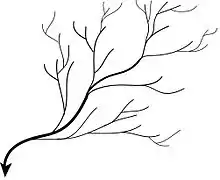
Dendritic drainage pattern
Dendritic drainage systems (from Greek δενδρίτης, dendrites, "of or like a tree") are not straight and are the most common form of drainage system. In this, there are many sub-tributaries (analogous to the twigs of a tree), which merge into tributaries of the main river (the branches and the trunk of the tree, respectively). They are seen to feed a river channel that matches and is strongly accordant to the overriding gradient of the land. Truly dendritic systems form in V-shaped valleys; as a result, the rock types must be quite impervious and non-porous.[3]
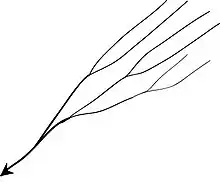
Parallel drainage pattern
A parallel drainage system occurs on a common slope down linear ranges (or of rivers between linear series of escarpments, parallel, elongate landforms like outcropping resistant rock bands), typically following natural faults or erosion (such as prevailing wind scars). The watercourses run swift and straight, with very few tributaries, and all flow in the same direction. This system forms on very long, uniform slopes, for instance, high rivers flowing southeast from the Aberdare Mountains in Kenya and many rivers of Myanmar.
This sometimes indicates a major fault that cuts across an area of steeply folded bedrock.
Trellis drainage pattern
The geometry of a trellis drainage system is similar to that of a common garden trellis. Along a strike valley, smaller tributaries feed into from the steep slopes of mountain sides. These tributaries enter the main river about perpendicular, causing a trellis-like appearance of the system. They form where hard and soft formations exist on both banks of the main river, and are reflective of height, accentuated by erosion. Trellis drainage is characteristic of folded mountains, such as the Appalachian Mountains in North America and in the north part of Trinidad.[2]
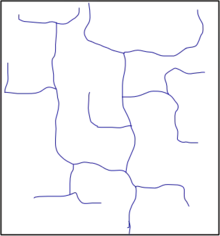
Rectangular drainage pattern
Rectangular drainage develops on rocks that are of approximately uniform resistance to erosion, but which have two directions of jointing at approximately right angles or 90 degrees. The joints are usually less resistant to erosion than the bulk rock so erosion tends to preferentially open the joints and streams eventually develop along the joints. The result is a stream system in which streams consist mainly of straight line segments with right angle bends and tributaries join larger streams at right angles.[2] This pattern can be found with the Arun River in Nepal.

Radial drainage pattern
In a radial drainage system, the streams radiate outwards from a central high point. Volcanos usually have archetypal features on which this commonly develops are modest or hard domes pattern develops when streams flow in many general directions (meaning quite long-term)
In India, the Amarkantak range and Ramgarh crater are most archetypal; and Dogu'a Tembien in Ethiopia.[4]
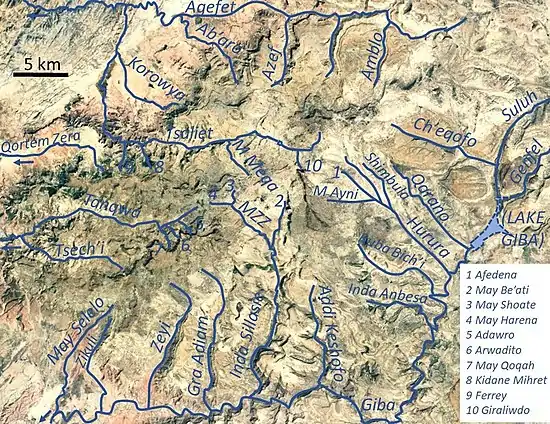
Centripetal drainage pattern
The centripetal is the inverse to the radial, ending with a depression, sea, or its inland form, an endorheic basin.
Deranged drainage pattern
A deranged drainage system is a drainage system in drainage basins where there is no coherent pattern to the rivers and lakes. It happens in areas where there has been much geological disruption. The classic example is the Canadian Shield. During the last ice age, the topsoil was scraped off, leaving mostly bare rock. The melting of the glaciers left land with many irregularities of elevation and a great deal of water to collect in the low points, explaining the large number of lakes which are found in Canada. The drainage basins are young and are still sorting themselves out. Eventually the system will stabilize.[1]
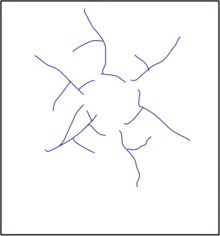
Annular drainage pattern
In an annular drainage pattern streams traces a tangential or greater concentric path along a belt of weak rock so, with others, a roughly traced out ring can be seen. It is best displayed by streams draining a maturely dissected structural dome or basin where erosion has exposed rimming sedimentary strata of greatly varying degrees of hardness, as in the Red Valley, which nearly encircles the domal structure of the Black Hills of South Dakota.
See also
References
- Pidwirny, M., (2006). "The Drainage Basin Concept". Fundamentals of Physical Geography, 2nd Edition.
- Ritter, Michael E., The Physical Environment: an Introduction to Physical Geography. 2006
- Lambert, David (1998). The Field Guide to Geology. Checkmark Books. pp. 130–131. ISBN 0-8160-3823-6.
- Amanuel Zenebe, and colleagues (2019). The Giba, Tanqwa and Tsaliet rivers in the headwaters of the Tekezze basin. In: Geo-trekking in Ethiopia's Tropical Mountains - The Dogu'a Tembien District. SpringerNature. doi:10.1007/978-3-030-04955-3_14. ISBN 978-3-030-04954-6.
- Easterbrook, Don J (1969). Chapter 7, Origins of Stream Valleys and Drainage Patterns. Principles of Geomorphology. McGraw-Hill Book Company. pp. 148-153. ISBN 0-07-018780-0 (this author defines dendritic, trellis, rectangular, angular, radial, annular, centripetal and parallel drainage patterns)